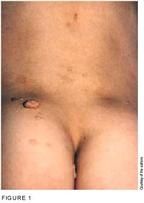Pediatric Dermatology: What's your DX?
A 7-year-old boy is brought to your office for evaluation of an asymptomatic birthmark on his left buttock. Except for proportional growth, there have been no changes in the lesions.
What's your DX?
PEDIATRIC DERMATOLOGY
By Otobia G. Dimson, MD,
Beth A. Drolet, MD, Nancy B. Esterly, MD, and Bernard A. Cohen, MD
A 7-year-old boy is brought to your office for evaluation of an asymptomatic birthmark on his left buttock. Except for proportional growth, there have been no changes in the lesions.
He is an otherwise healthy child, with no family history of neurofibromatosis or café-au-lait spots. However, his mother had similar lesions on her buttocks at birth, which were later removed.
Physical examination reveals multiple flesh-colored, pinkish yellow, soft, irregularly shaped papules in a unilateral dermatomal distribution on the left buttock (Figure 1). The largest lesion is a 1.2 cm flesh-colored, pedunculated papule with a cerebriform surface (Figure 2). Three to five scattered 4 mm brown macules are found on the back of his neck and lower mid-back. No café-au-lait lesions appear on the rest of his body. An area of postinflammatory hyperpigmentation is present over the lumbar spine.


1. What's the diagnosis?
2. Are there any systemic implications?
3. How would you manage this condition?
See page below for discussion.
Discussion
A biopsy taken from the largest lesion on the left gluteal area shows a polypoid lesion covered by an irregular epidermis (Figure 3). The underlying stroma contains fibrous connective tissue with interspersed lobules of mature adipose tissue. These changes are typical of nevus lipomatosus cutaneus superficialis (NLCS).

NLCS is a rare developmental anomaly characterized by the presence of ectopic adipose tissue. The incidence is equal for both genders, and there is no familial trend or associated abnormalities.
Two main types. The multiple (classic) form, first described by Hoffman and Zurhelle in a German publication in 1921, either is seen at birth or develops during the first three decades of life. It appears as asymptomatic, skin-colored, yellowish, soft papules and nodules commonly coalescing into plaques. Their surface can vary from smooth to a wrinkled or verrucoid texture. Comedones, with cystic dilation of the hair follicles and keratotic plugging at the surface of some nodular lesions, are sometimes seen.1 Lesions like these often occur along skin folds, especially in the pelvic or gluteal area. A few cases have been reported on the scalp,2 abdomen,3 and face.4
The solitary form is more common and occurs later in life. It consists of a single nodule or papule, usually at a site other than the lower trunk. The nodule of the solitary form is similar to the individual lobules of the multiple form, but tends to be somewhat larger and broader based.5
The differential. The clinical differential diagnosis of nevus lipomatosus cutaneus superficialis for the multiple form includes nevus sebaceus, multiple skin tags, connective tissue nevi, and warty nevi. Solitary lesions can be confused with neurofibroma, epidermal inclusion cyst, lipoma, pigmented melanocytic nevus, accessory nipple, and fibroepithelial papilloma or sweat gland tumor. Intradermal melanocytic nevi also have dermal collections of fat but also, usually, nests of nevus cells. Some giant skin tags also resemble NLCS; however, there is no fat in the papillary dermis. Goltz syndrome, an X-linked dominant disorder, consists of mature adipose tissue in the dermis but differs from NLCS in its association with ocular and skeletal abnormalities, and in the noticeable absence of collagen in the atrophic skin lesions.6
The pathogenesis of nevus lipomatosus cutaneus superficialis is unknown. One hypothesis is that NLCS is a hamartomous lesion originating from blood vessels since the mature fat cells in the lesions tend to be localized around dermal vessels. The findings on electron microscopy support this contention as the fat cells are closely associated with dermal capillaries. It has been suggested that they may arise from pericytes, as seen in fetal lipogenesis.
Treatment. Treatment of nevus lipomatosus cutaneus superficialis is usually unnecessary because the lesions are asymptomatic. However, irritated, traumatized, or disfiguring lesions can be surgically excised.7
The next installment of "Pediatric Dermatology: What's your DX?" will appear in July.
References
1. Lynch FW, Goltz RW: Nevus lipomatosus cutaneus superficialis. Arch Dermatol 1958;78:479
2. Chanoki M, Sugamoto I, Suzuki S, et al: Nevus lipomatosus cutaneus superficialis of the scalp. Cutis 1989;43:143
3. Dotz W, Prioleau PG: Nevus lipomatosus cutaneus superficialis: A light and electron microsopic study. Arch Dermatol 1984;120:376
4. Park HJ, Park CJ, Yi JY, et al: Nevus lipomatosus superficialis on the face. Int J Dermatol 1997;36:435
5. Wilson-Jones E, Marks R, Pongsehirun D: Naevus superficialis lipomatosus: A clinicopathological report of twenty cases. Br J Dermatol 1975;93:121
6. Lever WF, Schaumburg-Lever G: Histopathology of the Skin, ed 7. Philadelphia, JB Lippincott 1990, pp 722723
7. Reymond JL, Stoebner P, Amlard P: Nevus lipmatosus cutaneus superficialis: An electron microscopic study of four cases. J Cutan Pathol 1980;7:259
DR. COHEN, who serves as Section Editor for Pediatric Dermatology: What's your DX, is Director, Pediatric Dermatology and Cutaneous Laser Center, and Associate Professor of Pediatrics and Dermatology at Johns Hopkins University School of Medicine, Baltimore. He is a Contributing Editor for Contemporary Pediatrics.
DRS. DIMSON, DROLET, and ESTERLY are in the Departments of Dermatology and Pediatrics, Medical College of Wisconsin, Milwaukee.
Bernard Cohen. Pediatric Dermatology: What's your DX?. Contemporary Pediatrics 2000;4:41.
Having "the talk" with teen patients
June 17th 2022A visit with a pediatric clinician is an ideal time to ensure that a teenager knows the correct information, has the opportunity to make certain contraceptive choices, and instill the knowledge that the pediatric office is a safe place to come for help.
Recognize & Refer: Hemangiomas in pediatrics
July 17th 2019Contemporary Pediatrics sits down exclusively with Sheila Fallon Friedlander, MD, a professor dermatology and pediatrics, to discuss the one key condition for which she believes community pediatricians should be especially aware-hemangiomas.


















